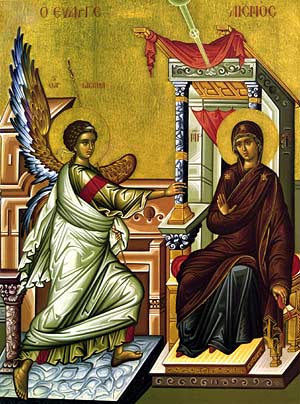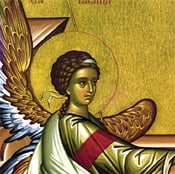
1. The Archangel Gabriel presents the good news of the coming of Christ to Mary (detail).
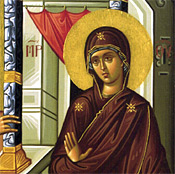
2. The Virgin Mary, who was chosen to be the Mother of God (detail).
The Archangel is shown with his feet spread apart as if he is running to share the good news with Mary (3). In his left hand is a staff, the symbol of a messenger. His right hand is extended toward Mary as he delivers the message and announces the blessing bestowed upon her by God (4).
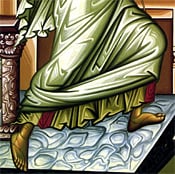
3. The position of Archangel Gabriel's feet suggest that he is running to share the news with Mary (detail).
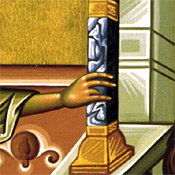
4. The Archangel's right hand is extended towards Mary as he announces the blessing bestowed upon her [Mary] by God (detail). On the right side of the icon the Virgin sits on an elevated seat, indicating that as the Mother of God she is “greater in honor than the cherubim, and beyond compare more glorious than the seraphim, who without corruption gave birth to God the Word.” In her left hand she holds a spindle of scarlet yarn (5) which depicts the task she was assigned of preparing the purple and scarlet material to be used in making the veil for the Temple in Jerusalem. Her right hand is raised in a gesture of acceptance in response to Gabriel’s message (6). Her posture expresses willing cooperation with God’s plan of salvation. The three stars on her garments (7) represent that she was a Virgin before, during, and after the birth of Christ.

5. Her left hand holds a spindle of crimson yarn depicting the task that she had of making the veil of the Temple in Jerusalem (detail).
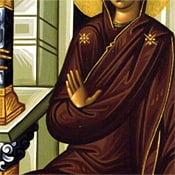
6. Mary's right hand is raised in acceptance of Gabriel's message (detail).
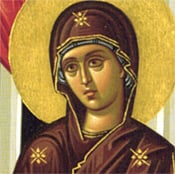
7. The three stars on the garments of the Theotokos represent that she was a Virgin before, during, and after the birth of Christ (detail).
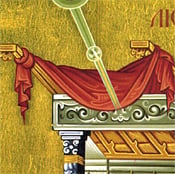
8. A depiction of the divine realm and the Holy Spirit coming upon the Theotokos (detail).
At the top of the icon the segment of a circle represents the divine realm (8), from which three rays emerge. This demonstrates the action of the Holy Spirit coming upon her.
Orthodox Christian Celebration of the Feast of the Annunciation of the Theotokos
The Feast of the Annunciation of the Theotokos is celebrated with the Divine Liturgy of Saint John Chrysostom which is conducted on the morning of the Feast and preceded by a Matins (Orthros) service. A Great Vespers is conducted on the evening before the day of the Feast. Scripture readings for the Feast are the following: At Vespers: Genesis 28:10-17; Ezekiel 43:27—44:4; Proverbs 9:1-11. At the Matins: Luke 1:39-49, 56. At the Divine Liturgy: Hebrews 2:11-18; Luke 1:24-38.
The Feast of the Annunciation in the Greek Orthodox Church also marks a day of national celebration for the people of Greece and those around the world of Greek descent. It was on March 25, 1821 when Greece officially declared its independence and began the revolution that would eventually give the nation its freedom after 400 years of rule by the Ottomans. In addition to the services for the Feast, festivities and parades are held and official proclamations are offered throughout the world in recognition of Greek Independence Day.
Resources
Festival Icons for the Christian Year by John Baggley (Crestwood, NY: St. Vladimir's Seminary Press, 2000), pp. 21-30.
The Festal Menaion. Translated by Mother Mary (South Canaan, PA: St. Tikhon’s Seminary Press, 1969) pp. 60-61.
The Incarnate God: The Feasts of Jesus Christ and the Virgin Mary, Catherine Aslanoff, editor and Paul Meyendorff, translator (Crestwood, NY: St. Vladimir’s Seminary Press, 1995).
The Life of the Virgin Mary, The Theotokos, written and compiled by Holy Apostles Convent (Buena Vista, CO: 1989).
The Synaxarion: The Lives of the Saints of the Orthodox Church, Vol. 4, compiled by Hieromonk Makarios of Simonos Petra and translated from the French by Mother Maria Rule and Mother Joanna Burton (Chalkidike, Greece: Holy Convent of the Annunciation of Our Lady, 2003) pp. 227-232.

